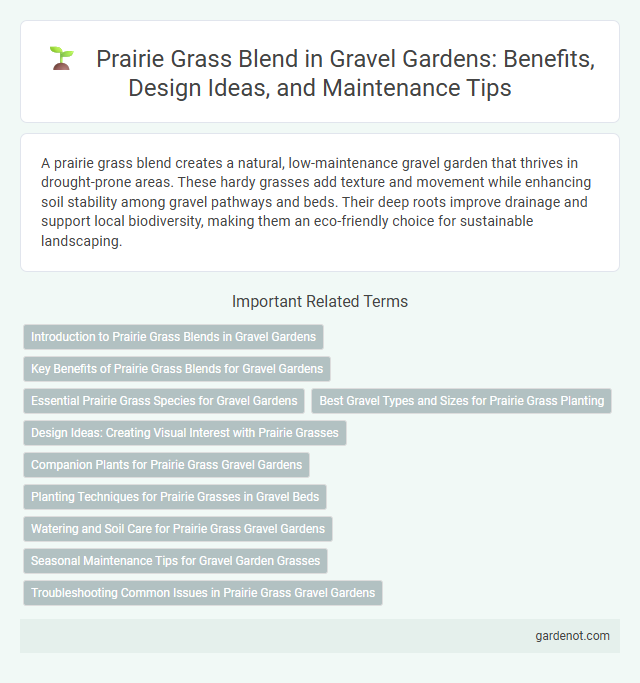A prairie grass blend creates a natural, low-maintenance gravel garden that thrives in drought-prone areas. These hardy grasses add texture and movement while enhancing soil stability among gravel pathways and beds. Their deep roots improve drainage and support local biodiversity, making them an eco-friendly choice for sustainable landscaping.
Introduction to Prairie Grass Blends in Gravel Gardens
Prairie grass blends consist of native grass species such as little bluestem, switchgrass, and Indian grass, which thrive in well-drained, gravelly soils and provide year-round texture and movement. These grasses enhance gravel gardens by improving soil stability, reducing erosion, and supporting local biodiversity through habitat creation. Their drought-resistant nature and minimal maintenance requirements make prairie grass blends an ideal choice for sustainable and visually appealing gravel garden landscapes.
Key Benefits of Prairie Grass Blends for Gravel Gardens
Prairie grass blends enhance gravel gardens by providing drought tolerance and low maintenance requirements, making them ideal for arid and well-drained environments. These grasses improve soil stability and reduce erosion with their deep root systems, promoting sustainable garden health. Their natural textures and seasonal color variations add aesthetic appeal, complementing the rugged look of gravel gardens.
Essential Prairie Grass Species for Gravel Gardens
Essential prairie grass species for gravel gardens include little bluestem (Schizachyrium scoparium), switchgrass (Panicum virgatum), and prairie dropseed (Sporobolus heterolepis), known for their drought tolerance and low maintenance. These grasses thrive in well-drained, rocky soils typical of gravel gardens while providing year-round texture and movement. Their deep root systems enhance soil stability and support native pollinators, promoting a sustainable and resilient garden ecosystem.
Best Gravel Types and Sizes for Prairie Grass Planting
Choosing the best gravel types for prairie grass planting involves selecting well-draining materials like pea gravel, decomposed granite, or crushed stone, typically sized between 1/8 to 3/8 inch, which promotes healthy root growth and prevents waterlogging. These gravel sizes allow adequate air circulation around prairie grass roots while minimizing soil erosion and supporting native grass species' natural habitat. Proper gravel selection enhances soil structure and moisture retention essential for establishing resilient, low-maintenance prairie gardens.
Design Ideas: Creating Visual Interest with Prairie Grasses
Prairie grass blends introduce dynamic textures and a naturalistic aesthetic to gravel gardens, enhancing visual interest through varied heights and movement. Incorporating species like little bluestem, switchgrass, and Indian grass creates a layered effect that thrives in well-drained, rocky soils. These grasses complement the gravel's neutral tones, providing contrast and seasonal color shifts that elevate the overall garden design.
Companion Plants for Prairie Grass Gravel Gardens
Prairie grass blends thrive in gravel gardens when paired with drought-tolerant companion plants such as coneflowers, black-eyed Susans, and yarrow, which enhance biodiversity and visual texture. These native perennials and grasses improve soil structure and attract pollinators, creating a sustainable and low-maintenance ecosystem. Integrating compact sedums and ornamental alliums further boosts resilience against harsh conditions typical in gravel landscapes.
Planting Techniques for Prairie Grasses in Gravel Beds
Prairie grass blends thrive in gravel gardens by using well-draining soil and planting in full sun to mimic native prairie conditions. Establish grasses by loosening gravel in planting spots to create root space, ensuring moisture retention without waterlogging. Regularly mulch with organic material to support moisture conservation and nutrient supply for strong root development.
Watering and Soil Care for Prairie Grass Gravel Gardens
Prairie grass blends thrive in well-drained, sandy or loamy soils, making them ideal for gravel garden environments. Watering should be infrequent but deep, allowing the soil to dry out between sessions to prevent root rot and encourage deep root development. Maintaining soil health with occasional organic mulch helps retain moisture and supports the natural nutrient cycle essential for prairie grass growth.
Seasonal Maintenance Tips for Gravel Garden Grasses
Prairie grass blends thrive in gravel gardens with minimal maintenance, requiring seasonal pruning to remove dead foliage and promote healthy growth. In late winter or early spring, cut back grasses to about 4-6 inches to prepare for new shoots and improve air circulation, reducing disease risk. Mulching lightly with gravel around the base helps retain moisture and suppress weeds, supporting the grasses through dry summer months.
Troubleshooting Common Issues in Prairie Grass Gravel Gardens
Prairie grass blends in gravel gardens often face challenges such as poor drainage, which can lead to root rot and stunted growth. Addressing soil compaction by aerating the gravel bed improves water infiltration and root expansion, promoting healthier plants. Regular monitoring for pests like aphids and fungal infections allows timely intervention, ensuring the prairie grasses thrive in gravel environments.
Prairie grass blend Infographic

 gardenot.com
gardenot.com